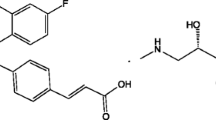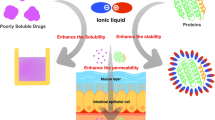ABSTRACT
This study evaluated the effect of counterions on the physicochemical properties of prazosin salts. Salt forms of prazosin, namely, mesylate, besylate, tosylate, camsylate, oxalate, and maleate, were prepared and compared with the marketed anhydrous and polyhydrate forms of prazosin hydrochloride. Physicochemical characterization was performed in the order of crystallinity, hygroscopicity, solubility, and stability to select the optimal salt(s). Permeability study in Caco-2 cell lines and in vivo bioavailability study in rat model were investigated to ascertain their biopharmaceutical advantage. All salt forms were crystalline, nonhygroscopic (except the anhydrous hydrochloride salt), and had solubility in the range of 0.2 to 1.6 mg/ml. All salts were physically and chemically stable at 40°C/75% relative humidity, but degraded in UV-visible light, except the anhydrous hydrochloride salt. Prazosin mesylate was selected as the optimal salt, as it possessed higher solubility, permeability, and bioavailability, compared to the commercial hydrochloride salts. Hydrochloride salt is reported to have poor bioavailability that is partially attributed to its low solubility and extensive common-ion effect in the gastric region. Factors like hydrophilicity of the counterion, hydration state of the salt, and melting point of the salt contribute to the physicochemical properties of the salts. This study has implications in the selection of an optimal salt form for prazosin, which is suitable for further development.







Similar content being viewed by others
REFERENCES
Berge SM, Bighley LM, Monkhouse DC. Pharmaceutical salts. J Pharm Sci. 1977;66:1–19.
Black SN, Collier EA, Davey RJ, Roberts RJ. Structure, solubility, screening, and synthesis of molecular salts. J Pharm Sci. 2007;96:1053–68.
Bowker MJ. A procedure for salt selection and optimization. In: Stahl PH, Wermuth CG, editors. Handbook of pharmaceutical salts: properties, selection and use. Weinheim: Wiley-VCH Inc.; 2002. p. 161–89.
Davies G. Changing the salt, changing the drug. Pharm J. 2001;266:322–3.
Gould PL. Salt selection for basic drugs. Int J Pharm. 1986;33:201–17.
Serajuddin ATM. Salt formation to improve drug solubility. Adv Drug Deliv Rev. 2007;59:603–16.
Stahl PH, Nakano M. Pharmaceutical aspects of the drug salt form. In: Stahl PH, Wermuth CG, editors. Handbook of pharmaceutical salts: properties, selection and use. Weinheim: Wiley-VCH Inc.; 2002. p. 83–116.
Kumar L, Amin A, Bansal AK. Preparation and characterization of salt forms of enalapril. Pharm Dev Technol. 2008;13:345–57.
Morris KR, Fakes MG, Thakur AB, Newman AW, Singh AK, Venit JJ, et al. An integrated approach to the selection of optimal salt form for a new drug candidate. Int J Pharm. 1994;105:209–17.
Gilman AG, Goodman LS, Gilman A. Goodman and Gilman’s the pharmacological basis of therapeutics. 6th ed. New York: McMillan; 1980. p. 806–7.
Hofmann BB. Adrenergic receptor blocking agents. In: Katzung BG, editor. Basic and clinical pharmacology. Los Altos: Lange Medical; 1984. p. 97–107.
Wu S. Polar and nonpolar interactions in adhesion. J Adhes. 1973;5:39–55.
Bianco EJ. Novel crystalline forms of prazosin hydrochloride. US Patent 4092315; 1978.
Kostek LJ. Prazosin hydrochloride. In: Brittain HG, editor. Analytical profile of drug substances and excipients, vol. 18. Amsterdam: Elsevier; 1989. p. 351–81.
Bergström CAS, Norinder U, Luthman K, Artursson P. Experimental and computational screening models for prediction of aqueous drug solubility. Pharm Res. 2002;19:182–8.
Kostek LJ. Prazosin hydrochloride. Analytical Profile of Drug Substances and Excipients. 1989;18:351–81.
Prazosin permeability. http://www.cyprotex.com/cloescreen/in-vitro-permeability/mdr1-mdck-permeability/. Accessed 1 May 2012.
Bianco EJ. Novel crystalline forms of prazosin hydrochloride. US Patent 4092315, Pfizer Inc.; 1978.
Kumar L, Bansal AK. Effect of humidity on the hydration behaviour of prazosin hydrochloride polyhydrate: thermal, sorption and crystallographic study. Thermochim Acta. 2012;525:206–10.
Volgyi G, Ruiz R, Box K, Comerc J, Bosch E, Takacs-Novak K. Potentiometric and spectrophotometric pK a determination of water-insoluble compounds: validation study in a new cosolvent system. Anal Chim Acta. 2007;583:418–28.
Tong W. Salt screening and selection: new challenges and considerations in the modern pharmaceutical R&D paradigm. http://www.pharmacy.utah.edu/pharmaceutics/pdf/Salt.pdf. Accessed 5 May 2012.
MDR1–MDCK permeability (P-glycoprotein substrate identification). http://www.cyprotex.com/cloescreen/in-vitro-permeability/mdr1-mdck-permeability/. Accessed 1 May 2012.
Bogardus JB. Common ion equilibria of hydrochloride salts and the Setschenow equation. J Pharm Sci. 1982;71:588–90.
Engel GL, Farid NA, Faul MM, Richardson LA, Winneroski LL. Salt form selection and characterization of LY333531 mesylate monohydrate. Int J Pharm. 2000;198:239–47.
Miyazaki S, Oshiba M, Nadai T. Precaution on use of hydrochloride salts in pharmaceutical formulation. J Pharm Sci. 1981;70:594–6.
Bowker MJ, Stahl PH. Preparation of water-soluble compounds through salt formation. In: Wermuth CG, editor. The practice of medicinal chemistry. London: Academic; 2008. p. 749–66.
Agharkar S, Lindenbaum S, Higuchi T. Enhancement of solubility of drug salts by hydrophilic counterions: properties of organic salts of an antimalarial drug. J Pharm Sci. 1976;65:747–9.
Gu L, Strickley RL. Preformulation salt selection—physical property comparison of the tris(hydroxymethyl)aminomethane salts of four analgesic/antiinflammatory agents with the sodium salts and the free acids. Pharm Res. 1987;4:255–7.
Anderson BD, Conradi RA. Predictive relationships in the water solubility of salts of a nonsteroidal anti-inflammatory drug. J Pharm Sci. 1985;74:815–20.
Chowhan JT. pH–solubility profiles of organic carboxylic acids and their salts. J Pharm Sci. 1978;67:1257–60.
Guerrieri P, Rumondor ACF, Li T, Taylor LS. Analysis of relationships between solid-state properties, counterion, and developability of pharmaceutical salts. AAPS PharmSciTech. 2010;11:1212–22.
Rubino JT. Solubility and solid state properties of the sodium salts of drugs. J Pharm Sci. 1989;78:485–9.
ACKNOWLEDGMENTS
Lokesh Kumar acknowledges the Department of Science and Technology of the Government of India and the Ranbaxy Science Foundation for providing the research fellowship to carry out this work. Services provided by the Central Instrumentation Laboratory at NIPER Mohali are also gratefully acknowledged.
Declaration of Interest
The authors report no conflict of interest. The authors alone are responsible for the content and writing of the paper.
Author information
Authors and Affiliations
Corresponding author
Rights and permissions
About this article
Cite this article
Kumar, L., Meena, C.L., Pawar, Y.B. et al. Effect of Counterions on Physicochemical Properties of Prazosin Salts. AAPS PharmSciTech 14, 141–150 (2013). https://doi.org/10.1208/s12249-012-9889-x
Received:
Accepted:
Published:
Issue Date:
DOI: https://doi.org/10.1208/s12249-012-9889-x




